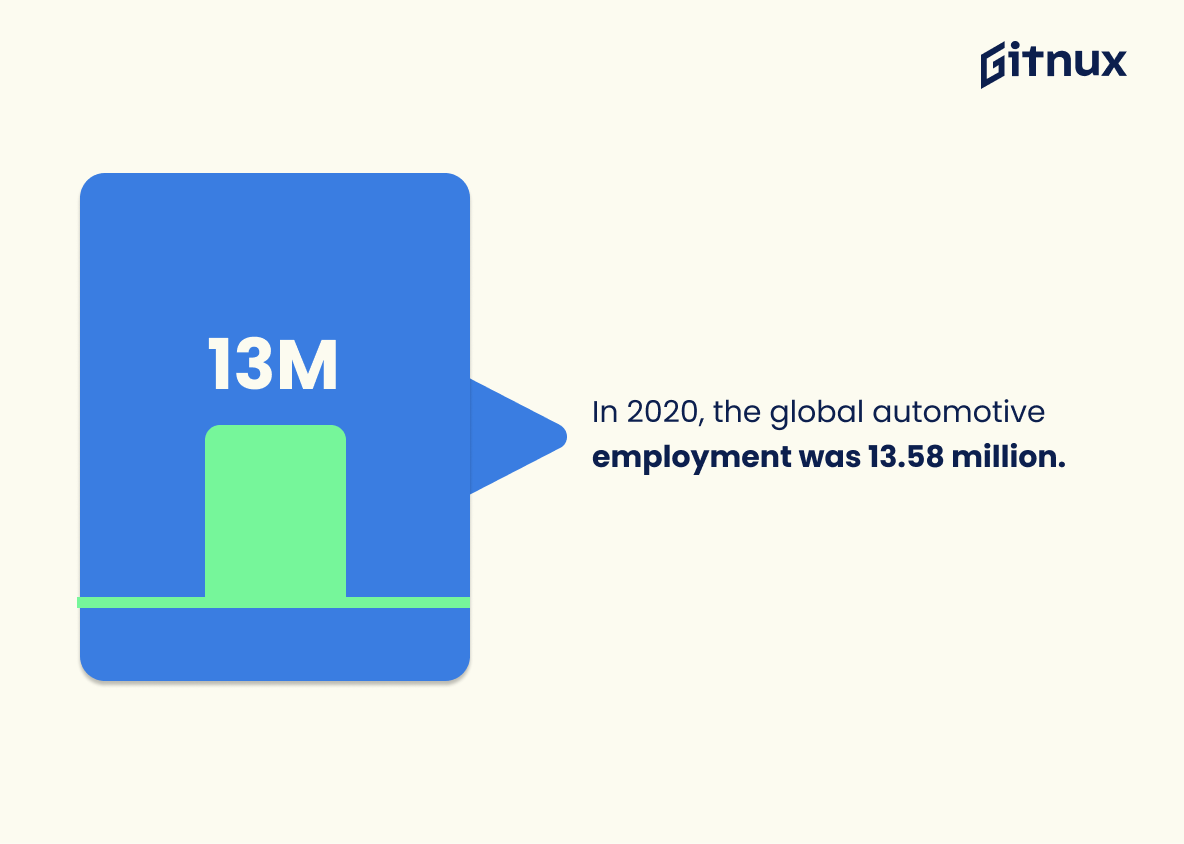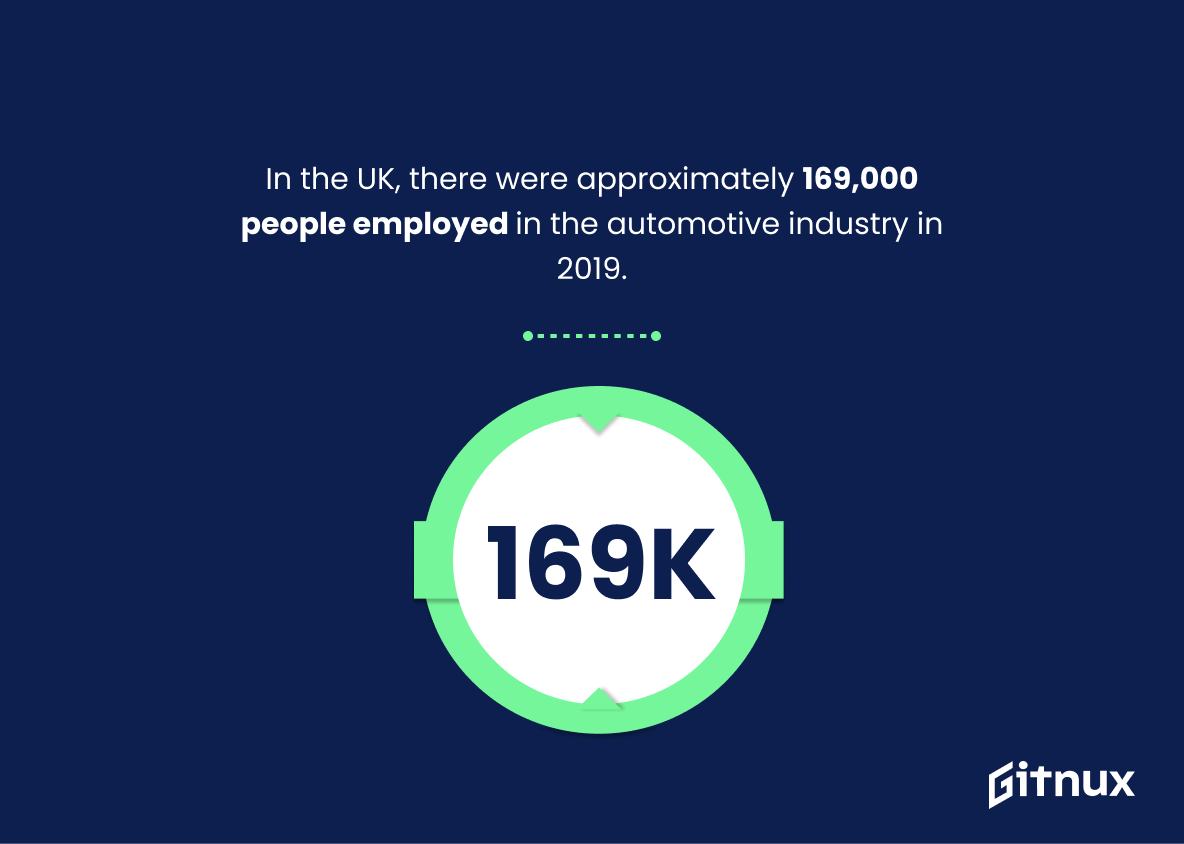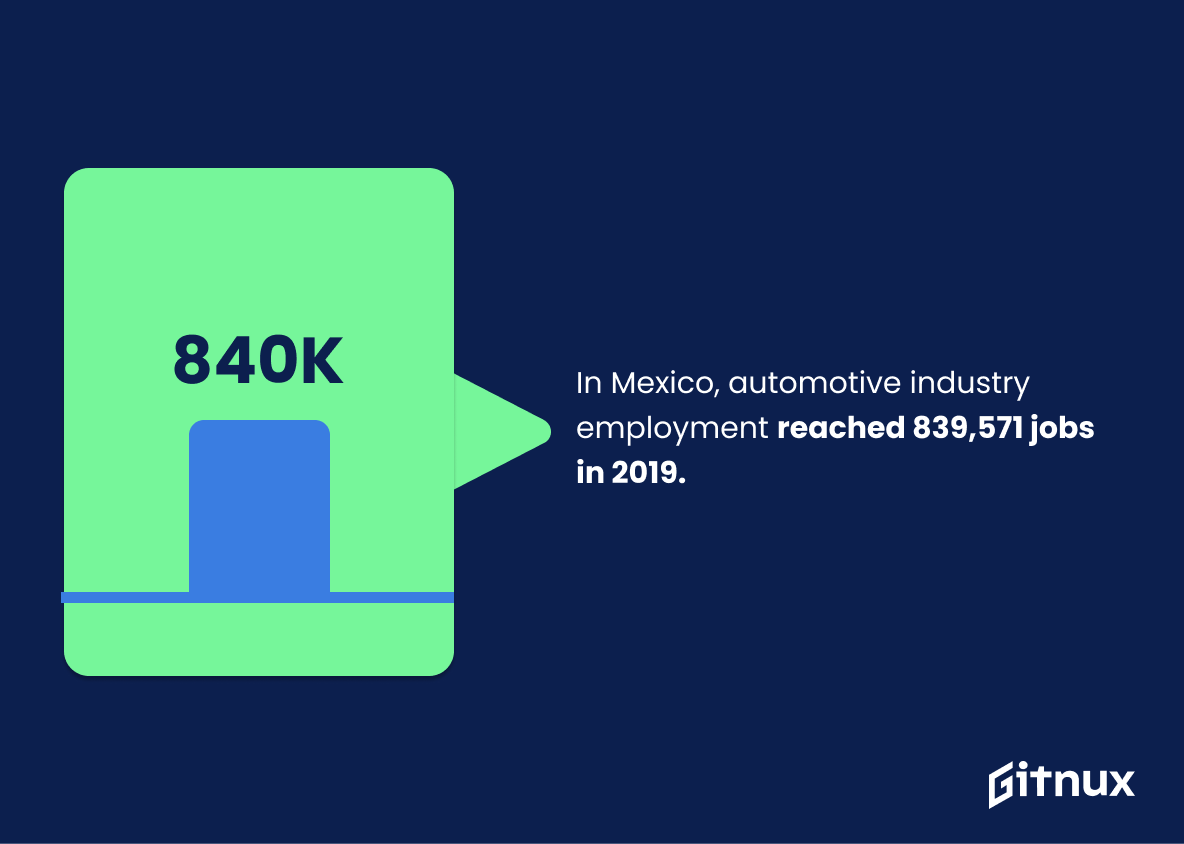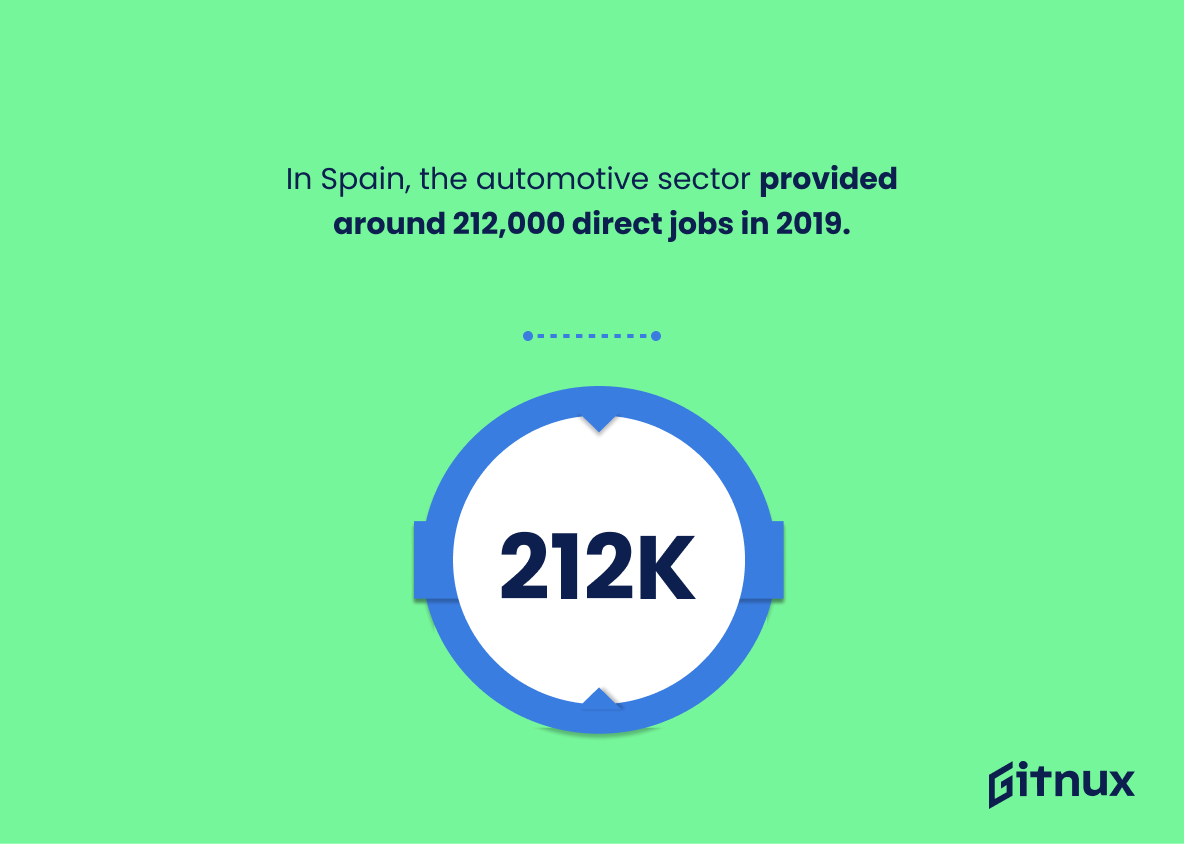The auto industry is a major employer in the United States, and its employment statistics can tell us a lot about the health of the economy. In this article, we’ll take a look at the latest auto industry employment statistics and discuss what they tell us about the industry and the economy.
We’ll also explore how the auto industry’s employment numbers have changed over time, and what the future may hold. Finally, we’ll look at how these statistics can help inform decisions about auto industry investments.
Auto Industry Employment: Important Statistics
The US auto industry exported 1.4 million passenger cars and light vehicles in 2020, representing a 6% increase, with Canada being the largest importer.
Toyota had the highest market share of 10.5% in 2021, followed by Volkswagen with 6.4% and Tesla with 2%.
Auto Industry Employment: Statistics Overview
The proportion of youth employees (aged 15-24) in Canada’s automotive manufacturing industry is lower than the youth proportion in the overall working age population.
The automotive industry is not providing enough job opportunities for young people, which could lead to a lack of skilled workers in the future.
The automotive industry has a large economic impact, with an annual turnover equivalent to the world’s sixth-largest economy and nearly 14 million global direct employment. However, the pandemic has significantly affected the industry, with 150,000 unionized and hundreds of thousands of non-unionized workers in the US impacted, and 42% of direct automotive manufacturing jobs in the EU affected.
This shows the scale of the economic impact of the pandemic on the industry, and the number of workers affected by it. This highlights the need for measures to support the industry and its workers, in order to mitigate the economic effects of the pandemic.
In South Africa Plant and machinery operators and assemblers make up the majority of employment in the South African auto industry, while other occupations such as elementary, sales and service, and clerical workers make up a much smaller portion.
The majority of employment opportunities in the auto industry in South Africa are in the plant and machinery sector, while other occupations are much less represented.
This can inform decisions about where to invest resources in order to create more employment opportunities in the auto industry.
In June 2022, motor vehicle and parts dealers employed nearly two million people while motor vehicles and parts manufacturing employees increased to 990,600, despite the projected decrease in automobile demand.
The auto industry is still a major employer in the US, despite the expected decrease in demand.
The US auto industry exported 1.4 million passenger cars and light vehicles in 2020, representing a 6% increase, with Canada being the largest importer.
This shows the US auto industry is growing, contributing 3% to the US GDP and attracting foreign investment.
The global automotive manufacturing market is expected to grow from $2.86 trillion in 2021 to $2.95 trillion in 2022, with an estimated 26% of new car sales being electric vehicles and 58 million new self-driving cars added to the world’s fleet in 2030.
This indicates that the industry is growing and that there is an increasing demand for electric and self-driving vehicles, which will likely create new job opportunities in the industry.
The auto industry provides direct and indirect jobs to over 13 million Europeans, accounting for 7% of total EU employment and 11.5% of all EU manufacturing jobs.
It demonstrates that the auto industry is a major employer in the EU, providing jobs to millions of people and accounting for a large portion of EU manufacturing jobs.
This information is useful for policy makers, businesses, and other stakeholders in the auto industry, as it provides insight into the importance of the industry and the potential economic impact of any changes or disruptions.
The “Motor vehicles, trailers, semi-trailers” sector has experienced a 35% increase in employment since the financial crisis, with an estimated 14 million workers employed in 2017 and a 68% increase in employment in China’s automotive industry from 2009 to 2017.
The auto industry has been able to recover from the financial crisis and continues to be a major employer of people globally.
Toyota had the highest market share of 10.5% in 2021, followed by Volkswagen with 6.4% and Tesla with 2%.
This shows the relative success of each company in the market, which can affect the number of jobs available in the industry.
The Big Three (General Motors, Ford, and Stellantis) have lower market caps than Toyota, but General Motors has the highest market share in the US.
This indicates that the Big Three are still competitive in the auto industry and their success is important for employment in the auto industry.
The auto industry directly employs over 2.5 million people in Europe.
There is a sheer number of people who rely on the industry for their livelihoods, and the importance of ensuring that the industry remains strong and competitive. It also serves as a reminder of the importance of investing in the industry to ensure that it continues to provide jobs and economic stability for millions of people.
In 2019, there were approximately 674,000 people employed in the automotive industry in Germany.
This demonstrates the sheer number of people employed in the sector, and the impact it has on the country’s economy. It also serves as a benchmark for comparison with other countries, and can be used to measure the success of the industry in Germany.
In 2019, the auto industry employed around 130,000 people in Canada.
The industry is a major employer, providing jobs to a large number of people. This is especially important in the context of a blog post about auto industry employment statistics, as it provides a tangible example of the industry’s impact on the Canadian economy.
In 2020, the global automotive employment was 13.58 million.
The automotive industry is a major employer, providing jobs to millions of people around the world. This statistic is especially important in the context of a blog post about auto industry employment statistics, as it provides a snapshot of the current state of the industry and its importance to the global economy.
In the UK, there were approximately 169,000 people employed in the automotive industry in 2019.
The industry is a major employer, providing jobs for a significant number of people. This statistic is especially relevant in the context of a blog post about auto industry employment statistics, as it provides a snapshot of the current state of the industry and its impact on the UK economy.
In India, the auto industry provides direct and indirect employment to more than 37 million people.
This serves as a reminder of the importance of investing in the auto industry, to ensure that it continues to provide employment opportunities for millions of people.
The Japanese automotive industry had an employment of about 5.3 million people in 2018.
The industry is a major employer in Japan, providing jobs to millions of people. This statistic is a powerful reminder of the importance of the automotive industry to the Japanese economy and its people.
In Brazil, around 1.3 million direct and indirect jobs were generated by the automotive industry in 2020.
This demonstrates the sheer number of people who are employed in the industry, both directly and indirectly, and the impact it has on the economy. It is a clear indication of the importance of the automotive industry in Brazil and its ability to create jobs and stimulate economic growth.
In Mexico, automotive industry employment reached 839,571 jobs in 2019.
The industry is thriving and creating jobs for the people of Mexico, which is a positive sign for the economy. This statistic is an important indicator of the health of the auto industry in Mexico and should be taken into consideration when discussing auto industry employment statistics.
In Australia, the automotive industry directly employs over 65,000 people.
This highlights the sheer number of people who are employed directly in the industry, and the impact it has on the economy. It also serves as a reminder of the importance of the industry in providing jobs and livelihoods for so many Australians.
In South Korea, the automotive sector accounts for 173,000 jobs in 2018.
This demonstrates the sheer number of jobs that are supported by the industry, highlighting the significance of the sector to the country’s economy. It also serves as a reminder of the potential impact of any changes in the industry, both positive and negative, on the livelihoods of those employed in the sector.
In France, the automotive industry employed about 200,000 people in 2019.
The industry is a major employer in the country, providing jobs for a significant portion of the population. This is especially relevant in a blog post about auto industry employment statistics, as it provides a concrete example of the industry’s impact on the economy.
In Italy, there were around 231,000 jobs in the automotive sector in 2020.
This serves as a benchmark for future growth and development in the sector, providing a valuable insight into the current state of the industry.
In Russia, the automotive industry employed about 205,000 people in 2019.
This demonstrates the sheer number of people who rely on the industry for their livelihoods, and the impact it has on the country’s economy. It is a powerful reminder of the importance of the automotive industry in Russia, and its importance to the nation’s workforce.
In 2019, there were approximately 60,000 people employed in the automotive industry in Sweden.
This demonstrates the sheer number of people employed in the sector, and the impact it has on the country’s economy. It also serves as a benchmark for future growth and development in the industry, providing a valuable insight into the current state of the automotive industry in Sweden.
In Spain, the automotive sector provided around 212,000 direct jobs in 2019.
The auto industry is a major employer in the country, providing a significant number of jobs and contributing to the overall economic growth. This statistic is especially relevant in the context of a blog post about auto industry employment statistics, as it provides a concrete example of the impact of the auto industry on the Spanish economy.
In Turkey, the automotive industry created 400,000 direct and indirect employment opportunities in 2018.
This is an impressive feat, and it speaks to the strength of the industry in the country. It is a reminder of the importance of the automotive industry in Turkey and its potential to create even more employment opportunities in the future.
In China, the automotive industry employed around 4 million people in 2020.
The industry is a major employer in the country, providing jobs to millions of people. This is significant, as it highlights the importance of the automotive industry in the Chinese economy and its impact on the lives of its citizens.
In Argentina, the automotive sector employed about 105,000 people in 2018.
This demonstrates the sheer number of people who are employed in the industry, and the impact it has on the country’s economy. It is a powerful reminder of the importance of the auto industry in Argentina, and the need to ensure that it remains a viable and prosperous sector.
Conclusion
The auto industry is an ever-changing and dynamic sector of the economy. As technology advances, the industry is likely to continue to grow, creating more jobs and opportunities for those interested in the field.
While the current employment statistics for the auto industry may not be as promising as some would hope, the future looks bright for those looking to enter the industry. With the right skills and knowledge, the auto industry can provide a rewarding and lucrative career.
References
1 – https://www.futureautolabourforce.ca/wp-content/uploads/2020/06/TREND-REPORT-Youth-June-2020.pdf
2 – https://www.ilo.org/wcmsp5/groups/public/—ed_dialogue/—sector/documents/briefingnote/wcms_741343.pdf
3 – https://naamsa.net/employment-and-skills/
4 – https://www.statista.com/statistics/276474/automotive-industry-employees-in-the-united-states-by-sector/
5 – https://www.zippia.com/advice/automotive-industry-statistics/
6 – https://www.statista.com/statistics/574151/global-automotive-industry-revenue/
7 – https://www.acea.auto/figure/employment-trends-in-eu-automotive-sector/
8 – https://www.ilo.org/wcmsp5/groups/public/—ed_dialogue/—sector/documents/meetingdocument/wcms_741659.pdf
9 – https://www.statista.com/statistics/316786/global-market-share-of-the-leading-automakers/
10 – https://www.investopedia.com/terms/b/bigthree.asp
11 – https://www.export.gov
12 – https://www.statista.com
13 – https://www.fcai.com.au
14 – https://www.smmt.co.uk
15 – https://www.acea.auto
16 – https://www.fkg.se
17 – https://www.ibef.org
18 – https://apma.ca
19 – https://investinbrazil.biz
20 – https://www.acea.be
21 – https://www.marklines.com















